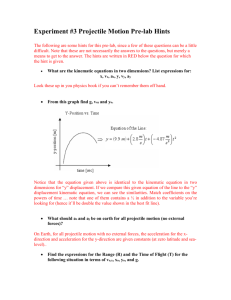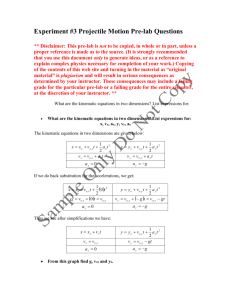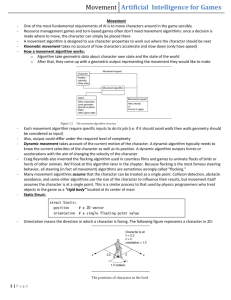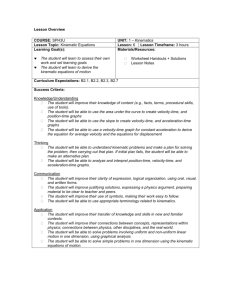Track Introduction and Commands
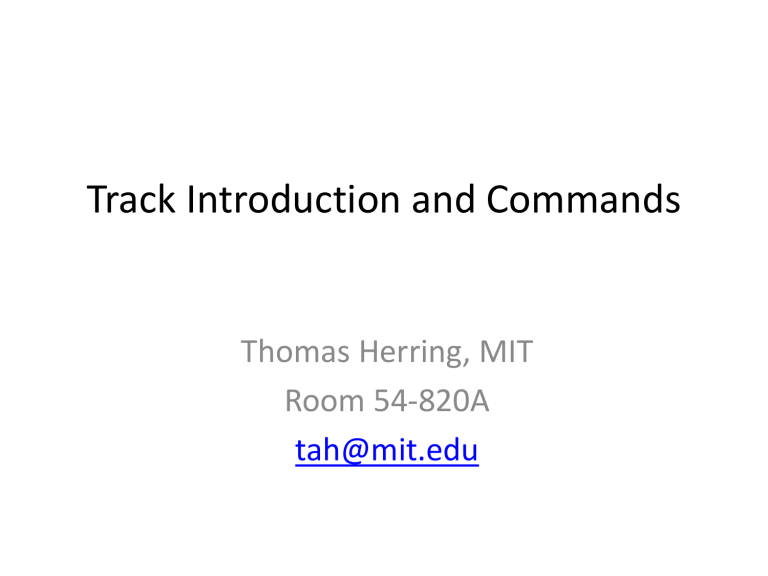
Track Introduction and Commands
Thomas Herring, MIT
Room 54-820A tah@mit.edu
Kinematic GPS
• The style of GPS data collection and processing suggests that one or more GPS stations is moving (e.g., car, aircraft)
• To obtain good results for positioning as a function of time it helps if the ambiguities can be fixed to integer values.
Although with the “back smooth” option in track this is nit so critical.
• Program track is the MIT implementation of this style of processing. The real time version is trackRT and trackRTB
• Unlike many programs of this type, track pre-reads all data before processing. (This approach has its pros and cons)
07/11/2013 Track Kinematic 2
General aspects
• The success of kinematic processing depends on separation of sites
• If there are one or more static base stations and the moving receivers are positioned relative to these.
• For separations < 10 km, usually easy
• 10>100 km more difficult but often successful
• >100 km very mixed results depending on quality of data collected.
07/11/2013 Track Kinematic 3
Slow moving sites
• For slow moving sites (glaciers, early landslides), gamit solution can be more easily automated than track solutions and can generate high quality results especially if motion is nearly linear (with high rates 100 m/yr for example).
• With gamit solutions:
– Put best estimate of velocity in the apriori coordinate file used in gamit
(position estimate will be the mean offset from this linear model).
– Use sh_gamit with –sessinfo option to have multiple solutions be day (set start time and duration of each session e.g., 8 3-hr sessions per day; 360 30-sec epochs per session). Use –netext option to put each session in different directory (-noftp after first session also speeds up run if sites missing).
– Some tuning of minxf in process.defaults and reduce values in trim_oneway_tol in autcln.cmd so that small data sets are not removed.
• Track can also be used for these types of an
07/11/2013 Track Kinematic 4
Issues with length
• As site separation increases, the differential ionospheric delays increases, atmospheric delay differences also increase
• For short baselines (<2-3 km), ionospheric delay can be treated as ~zero and L1 and L2 ambiguities resolved separately. Positioning can use L1 and
L2 separately (less random noise).
• For longer baselines this is no longer true and track uses the MW-WL to resolve L1-L2 cycles
• IONEX files can now be included to help with the ionospheric delay on long baselines.
07/11/2013 Track Kinematic 5
Track features
• Track uses the Melbourne-Wubena Wide Lane to resolve
L1-L2 and then a combination of techniques to determine
L1 and L2 cycles separately.
• “Bias flags” are added at times of cycle slips and the ambiguity resolution tries to resolve these to integer values.
• Track uses floating point estimate with LC, MW-WL and ionospheric delay constraints to determine the integer biases and the reliability with which they are determined.
• Kalman filter smoothing can be used. (Non-resolved ambiguity parameters are constant, and atmospheric delays are consistent with process noise). When atmospheric delays are estimated, the smoothing option should always be used.
07/11/2013 Track Kinematic 6
Ambiguity resolution
• Algorithm is “relative-rank” approach. Chi-squared increment of making L1 and L2 ambiguities integer values for the best choice and next best are compared. If best has much smaller chi-squared impact, then ambiguity is fixed to integer values.
• Test is on inverse-ratio of chi-squared increments (i.e.,
Large relative rank (RR) is good).
• Chi-squared computed from:
– Match of LC combination to estimated value (LC)
– Match to MW-WL average value (WL)
– Closeness of ionospheric delay to zero (less weight on longer baselines) (LG)
• Relative weights of LC, WL and LG can be set.
• Estimates are iterated until no more ambiguities can be resolved.
07/11/2013 Track Kinematic 7
Basic GPS phase and range equations
•
Basic equations show the relationship between pseudorange and phase measurements
f
1i f
2 i k k = g i k
= g i k
/ l
/ l
2
1
-
I i k
-
I i k
/
/ l l
2
1
+
N
1i k
æ
è f
1 f
2
ö
ø
2
+ v
1i k
+
N
2 i k + v
2 i k
R
1i k
R
2 i k
= g i k
= g i k
+
I i
+
I i k k + w
1i k
æ
è f f
1
2
ö
ø
2
+ w
2 i k g is range,
I is ionospheric delay l is wavelength
v and w are noise
07/11/2013 Track Kinematic 8
L1-L2 and Melbourne-Wubbena
Wide Lane
• The difference between L1 and L2 phase with the L2 phase scaled to the L1 wavelength is often called simply the widelane and used to detect cycle slips. However it is effected fluctuations in the ionospheric delay which in delay is inversely proportional to frequency squared.
• The lower frequency L2 has a larger contribution than the higher frequency L1
• The MW-WL removes both the effects on the ionospheric delay and changes in range by using the range measurements to estimate the difference in phase between L1 and L2
07/11/2013 Track Kinematic 9
MW-WL Characteristics
• In one-way form as shown the MW-WL does not need to be an integer or constant
• Slope in one-way is common, but notice that both satellites show the same slope.
• If same satellite-pair difference from another station (especially when same brand receiver and antenna) are subtracted from these results then would be an integer (even at this one station, difference is close to integer)
• The MW-WL tells you the difference between the L1 and L2 cycles. To get the individual cycles at L1 and L2 we need another technique.
• There is a formula that gives L1+L2 cycles but it has 10 times the noise of the range data ( f/ f) and generally is not used.
07/11/2013 Track Kinematic 10
Melbourne-Wubena Wide Lane
mw
wl
= f
1
-
(MW-WL)
f
2
-
(f
1
(f
1
f
2
+ f
2
)
) [
R
1 f
1
/ c
+
R
2 f
2
/ c
]
• Equation for the MW-WL. The term Rf/c are the range in cycles (notice the sum due to change of sign ionospheric delay)
• The
f/
f term for GPS is ~0.124 which means range noise is reduced by a about a factor of ten.
• The ML-WL should be integer (within noise) when data from different sites and satellites (double differences) are used.
• However, receiver/satellite dependent biases need to be accounted for (and kept up to date).
07/11/2013 Track Kinematic 11
Example MW-WL PRN 07 and PRN 28)
07/11/2013
-23578697
-23578698
-23578699
-23578700
-23578701
-23578702
-23578703
-23578704
-23578705
19.0
MW_WL_07_cycles
20.0
etab.07
21.0
22.0
Time_Hrs
Track Kinematic
MW_WL_28_cycles
23.0
-24380364
-24380365
-24380366
-24380367
-24380368
-24380369
-24380370
-24380371
24.0
-24380372
12
EX-WL Extra-Wide-lane
• The other measure of the difference in cycles between
L1 and L2 used by track is the EX-WL (Extra Widelane).
•
EX
-
WL
= f
1
f
2 l
2 ; l
2 l
1
=
1.28
This measure is independent of geometry but is affected by the ionospheric delays. On short separations this measure is often more robust than the
MW-WL.
• When we look at track bias fixing note that a 1 L1 and
L2 slip (1/1 slip) changes the EX-WL by only 0.28 cycles
(53 mm). (This is just 82 mm of L1 ionospheric delay,
0.5 TECU)
07/11/2013 Track Kinematic 13
Basic Inputs for track.
• Track runs using a command file
• The base inputs needed are:
– Obs_file specifies names of rinex data files. Sites can be K kinematic or F fixed
– Nav_file orbit file either broadcast ephemeris file or sp3 file
– Mode air/short/long -- Mode command is not strictly needed but it sets defaults for variety of situations
– Normally back_type smooth would also be specified.
• Normally start with just these commands and see how the run looks and based on this output start tuning track.
07/11/2013 Track Kinematic 14
Basic use
• Recommended to start with above commands and see how the solution looks
• Usage: track -f track.cmd >&! track.out
• Basic quality checks:
• egrep ‘^PRMS|TYPE’ on summary file or track out (RMS by PRN in mm)
TYPE Site DT ALL 02 05 08 10 15 21 26 29
PRMS usn3 LC 7.0 9.4 3.6 10.5 7.9 7.5 7.2 3.9 3.5
TYPE Site DT ALL 02 05 08 15 21 26 29
PRMS mitb LC 7.2 8.3 3.7 11.0 6.5 8.4 3.6 4.5
TYPE Site DT ALL 02 05 08 15 21 26 29
PRMS rovr LC 7.4 7.8 4.3 12.5 6.8 8.5 4.4 4.5
• grep Kinematic track.out | head -<number of sites>
TRACK Version 1.27 GPS Kinematic trajectory program
Kinematic site usn3 appears static Coordinate RMS XYZ 1.84 2.81 2.23 m, Apriori coordinates good: Diff XYZ -0.25 0.74 -0.17 m
Kinematic site mitb appears static Coordinate RMS XYZ 0.95 1.46 1.11 m, Apriori coordinates good: Diff XYZ 0.93 -1.77 1.70 m
Kinematic site rovr appears dynamic Coordinate RMS XYZ 17.84 18.26
17.40 m.
• The message is repeated during the run (thus the head above) but the RMS position drops to 0.00 for non-kinematic sites. This is a pseudo range solution so RMS will be high. Make sure site behave the way you think they should.
• Check track.sum file for ambiguity status and RMS scatter of residuals.
07/11/2013 Track Kinematic 15
Track command line
% track -f <command file> -a <ambiguity file> -d <day> -w <week> -s <S01>
<S02> .. <S10> where <command file> is a required file containing a list of commands to control the program (see below)
<ambiguity file> is an optional file containing a modified set of integer bias parameters and settings (see full description below).
<day> the string in this argument replaces <day> in the command file lines
(e.g., bas1<day>0.03o will become bas12220.03o if the -d 222 option is given.
<week> the string here will replace any <week> strings in the command file
(useful for the nav_file name which could be a week of concatenated sp3 files.
<S01>, <S02> .. <S10> are up to 10 strings that can be replaced in the command file i.e. the string <S01> in the command file will be replaced by the first string, <S02> by the second and so on. If one the strings is called space (all lower case), the corresponding <SXX> entry will be replaced by a blank character (This provides a means to un-comment lines)
07/11/2013 Track Kinematic 16
Basic use: Things to check
• Check on number of ambiguities (biases) fixed
– grep FINAL <summary file>
• A 3 in column “Fixd” means fixed, 1 means still floating point estimate
• If still non-fixed biases or atmospheric delays are estimated then smoothing solution should be made
(back_type smooth)
• output in NEU, geodetic, DHU, XYZ coordinates. NEU are simple North East distances and height differences from fixed site. (Convenient for plotting and small position changes). DHU is similar but difference are from the apriori coordinates of the site.
07/11/2013 Track Kinematic 17
More advanced features
•
Track has a large help file which explains strategies for using the program, commands available and an explanation of the output and how to interpret it.
•
It is possible to read a set of ambiguities in.
– Works by running track and extracting FINAL lines into an ambiguity file. Setting 7 for the Fixd column will force fix the ambiguity. ambiguity file is then read into track (-a option or ambin_file)
07/11/2013 Track Kinematic 18
Advanced features
•
Commands allow control of how the biases are fixed and editing criteria for data
•
Editing is tricky because on moving platform, jumps in phase could simply be movement
•
Ionospheric delay and MW WL used for editing.
•
Explicit edit_svs command
•
Explicit add and remove bias flags
07/11/2013 Track Kinematic 19
Main Tunable commands
• BF_SET <Max gap> <Min good>
– Sets sizes of gaps in data that will automatically add bias flag for possible cycle slip. Default is 1, but high rate data often misses measurements.
• ION_STATS <Jump>
– Size of jump in ionospheric delay that will be flagged as cycle slip.
Can be increased for noisy data
• FLOAT_TYPE <Start> <Decimation> <Type> <Float sigma
Limits(2)> <WL_Fact> <Ion_fact> <MAX_Fit> <RR>
– Main control on resolving ambiguities. Float sigma limits (for LC and WL) often need resetting based on data quality.
– <WL_Fact> <Ion_fact> control relative weights of WL and LG chisquared contributions.
– RR is relative rank tolerance
• Fcode in output is diagnostic of why biases are not resolved.
07/11/2013 Track Kinematic 20
Other common commands
• USR_ADDBF <site> <prn #> <time (ymdhms)>
Allows user to add a bias file at site <site> for PRN <prn #> at time <time>. First valid measurement at or after time will be flags.
• USR_DELBF <site> <prn #> <time (ymdhms)>
Allows user to delete a bias file at site <site> for PRN <prn #> at time <time>. The time must match within 50% of sampling interval.
07/11/2013 Track Kinematic 21
Some results
• Examine the short baseline MIT results: Look at this example in more detail later
• April 4, 2010 El-Mayor Cucapah earthquake in
Baja California: 5-Hz results. Look later at long baseline processing for these sites.
• Track results are generated in two steps:
– First solution uses zero process noise except during time of earthquake (long baseline solution)
– Final results generated with fixed ambiguities from first solution read in (-a option).
– Long baseline ambiguity resolution with stochastic site coordinates needs LC estimate which can noisy due to stochastics.
07/11/2013 Track Kinematic 22
07/11/2013 Track Kinematic
Coseismic offsets
• Offsets based on
2-days before and after earthquake.
• Two days used is reduce leakage of postseismic motions.
• Red Star is epicenter; blue circle is 60 km
(15-20 seconds surface wave speed)
23
07/11/2013 Track Kinematic
Zoom around border
• Sites near the epicenter.
• Blue circle is
60 km radius
• Displacement s
P494 200 mm
P496 182 mm
P497 97 mm
…
P491 9 mm
24
07/11/2013
1Hz reference site
Reference site for high rate positioning
High-rate
GPS site download
• High rate data from these sites downloaded after event.
• Most sites are 5-Hz; more distant sites are 1-
Hz.
25 Track Kinematic
07/11/2013 Track Kinematic
Sites in coseismic region
• Sites shown have 5-Hz data for 3days before and after the earthquake
• Examine sequence of sites along
US/Mexico border and
North
26
200
0
‐200
‐400
‐600
‐800
07/11/2013
0
P496
DNorth p496 (mm)
DEast p496 (mm)
600
400
200
0
‐200
80 160 240 320 400 480 560
‐400
27
0
‐200
‐400
400
200
‐600
‐800
07/11/2013
0
P494
DNorth p494 (mm)
DEast p494 (mm)
600
80
‐200
160 240 320
Track Kinematic
400 480 560
‐400
28
400
200
0
200
0
‐200
‐400
‐600
‐800
07/11/2013
0 80 160
P500
600
400
200
0
400
DEast p500 (mm)
DNorth p500 (mm)
480
‐200
560
‐400
29
200
0
‐200
‐400
‐600
‐800
07/11/2013 0 80 160
P066
600
400
200
0
400
DEast p066 (mm)
DNorth p066 (mm)
480
‐200
560
‐400
30
200
0
‐200
‐400
‐600
‐800
07/11/2013 0 80 160
P473
600
400
200
0
400
DEast p473 (mm)
DNorth p473 (mm)
480
‐200
560
‐400
31
200
0
‐200
‐400
‐600
‐800
07/11/2013 0
P742
600
400
80
200
0
160 Track Kinematic 320 400
DEast p742 (mm)
DNorth p742 (mm)
480
‐200
560
‐400
32
‐20
0
20
40
Surface wave arrival at P725
• P725 is ~600 km from epicenter. This signal common to sites is the arrival at the “reference site”
DEast p725 (mm)
DEast p066 (mm)
DEast p473 (mm)
DEast p742 (mm)
‐60
‐40
‐20
0
‐40
20
‐60
40
‐80
60
‐100
280
33
180 200 220
Seconds from event
240 260
Track Output Files
• Track outputs progress directly to the screen and this output can be re-directed with > to a file. (Generally track_xxx.out)
• Summary file (track.sum by default)
• Position files (NEU,GEOD,DHU,XYZ)
• Phase residual files (optional)
• Wide-lane value files: (optional, sometime useful if cycle slip missed)
• Meaning of output entries discussed in help file.
07/11/2013 Track Kinematic 34
Summary file
• This file is a short summary of the run. It lists
– files and parameters that were used for the run
– Process noise values
– Any editing specified by the user
– FINAL bias flag report. The Fixd column indicates if the bias was fixed (denoted by value 3).
– Summary of residual scatter as function of site and satellite and versus elevation angle (These are RMS differences from fixed station)
• Generally residual RMS should be less than 10 mm although values up to 20 mm can be OK.
07/11/2013 Track Kinematic 35
Output file from track
• Track outputs extensive information during its run.
– The initial output is status during reading of the rinex files. Errors in the files are reported here and a summary of satellites seen.
• Most common problem here is no sampling rate given in rinex file. Command INTERVAL needs to be used.
– An initial pseudorange solution establishes the trajectory of the kinematic sites and statistics on differences from apriori coordinates and RMS scatter of trajectory are given.
– Bias flags being added due to jumps in wide-lanes are reported.
– Bad apriori coordinates can lead to BAD PREFIT data
(see site_pos)
07/11/2013 Track Kinematic 36
Output continued
• Summary of Bias flags needed with estimates of numbers of cycles. These are reported by site, satellite and epoch range.
Initial set are labeled INITIAL.
• Estimates of mean MW-WL and Mean Ionospheric delay (EX-
WL) along with sigma estimates are given. (A correlation time is assumed in the sigma calculation).
• Dependences of biases are given with the ‘DD bias refs’ entries. Although listed as one ways, values are double differences.
07/11/2013 Track Kinematic 37
Output continued
• Iteratively, track tries to resolve the ambiguities to integer values.
– Floating point estimates of the biases as they are estimated.
– RMS fit of the double difference residuals
– Any bad double differences are reported and removed (repeating values can be indication of missed cycle slip).
– Bias flag fixing report: Fix column (T or F) indicates if bias was successfully fixed. The Fcode column indicates why it was not fixed.
• This sequence is repeated until an iteration when no new biases are fixed.
• The final position estimates are then computed and output in the requested formats.
07/11/2013 Track Kinematic 38
Fcode Interpretation
• For float_type LC the Fcode is
• S -- Floating point estimate sigma too large (Sig Limit)
• W -- MW WL sigma too large
• R -- Relative rank not large enough
• C -- Chi**2 increment too large for the best choice of ambiquities
• O -- One other bias in the double differences not fixed yet.
* BF S PRN Epoch Range F Estimate dLC Sig Limit Relative Rank Fix Fcode Change L1 L2 Residual L1 L2 Fits Best LC WL LG
175 5 PRN 15 1 43 1 1.86 +0.24 SL 0.25 RR 2.36 F F --R-- dL1,2 3 3 dL12 0.31 -0.08 Fits 11.7 0.8 0.3 105.7
48 2 PRN 07 1 429 1 -0.16 +0.74 SL 0.25 RR 9660.51 F F S---O dL1,2 0 0 dL12 -0.28 -0.02 Fits 0.4 0.1 0.1 2.1
07/11/2013 Track Kinematic 39
Improving ambiguity resolution
• The Fcodes can indicate how to fix ambiguities that track by default is not able to fix.
• Common fixes:
– S and W indicate that the estimated sigmas on the float estimates and/or MW-WL are too large. If the relative ranks are large, the the sigma tolerances can be increased with the Float_type command,
– If ambiguities seem to have the same value then user_delbf can be used to remove an extra one but care should be taken because some receivers can have 1/1 L1 L2 cycle slips.
– Chi-squared increments may be too large (especially LG (ionosphere) and sometime WL so by down weighting in the float_type command, relative rank can be improved.
07/11/2013 Track Kinematic 40
Input ionospheric delay model
• Version 1.26 and greater of track have the ability to read a gridded ionospheric delay model. The format of this model is expected to match the current IGS global ionospheric models available from cddis.gsfc.nasa.gov
in the gps/productions/ionex/<yyyy>/<ddd> directory.
• Command
IONEX_FILE <file name> invokes the features. The EX-WL estimates are affected by this model and its inclusion should help ambiguity resolution on long baselines (>100 km).
07/11/2013 Track Kinematic 41
Use of input ambiguity file
•
For certain analyses, it can be useful to manually supply ambiguity file to track using either the -a option or the amb_file command.
•
The ambiguity file can be generated by grep’ing FINAL in the track summary or output file and re-directing into an
07/11/2013 Track Kinematic 42
Other tunable parameters
• Process noise to be used on the atmospheric delay is variable
– If noise is too large, then height estimates and atmospheric delay estimates are highly correlated
– If noise is to small, then atmospheric delay variations map into height variations
– For aircraft, track now has process noise that depends on the rate of change of altitude.
– Units of process noise are random-walk change in meters per unit time (standard deviation grows as square of number of epochs), where the default unit time is the sampling interval, but the unit can be set with the time_unit command
07/11/2013 Track Kinematic 43
Track Commands: “Rules”
•
Track command files share the properties as globk command files:
– All command lines must start with a less one blank space; arguments are separated by spaces
– Order of commands is generally not important except that later versions of a command replace the previously assigned arguments
– Site dependent commands in track issue the command name first and then lines that contain station names and arguments (all is a valid name).
07/11/2013 Track Kinematic 44
Track commands
(The @ denotes at least one blank in the lines below).
@ OBS_FILE
@ Site RX_file Type
Command gives the site 4-char codes and the corresponding rinex file name. The
<Type> is set to F for a fixed site, and K for a kinematic site.
e.g., obs_file bish bisha289.97o F t39a t391a289.97o K
07/11/2013 Track Kinematic 45
Track Commands
@ NAV_FILE <name> <SP3/NAV>
Gives the name of the SP3 or NAV file with orbits and clock information (e.g., igs SP3 files).
When processing 24-hours of data, SP3 files from the preceding and postceding days should be concatenated together (headers removed at the day boundaries).
e.g., nav_file igs09274.sp3 SP3
(GAMIT program doy can be used to get GPS week and day number from calendar date).
If NAV is used as the type then a broadcast ephemeris file is used.
07/11/2013 Track Kinematic 46
Track Commands
@ MODE <Type>
The MODE command allows the setting of defaults for the type of data being processed. These setting can then be overwritten if desired by use of the commands below. Three default setting modes are supported for <Type>:
AIR -- Assumed to be high-sample rate aircraft. Sets the analysis_type to LC, and allows gaps of 4-epochs, and minimum data of 120 epochs
(1 minute for 2Hz data).
SHORT -- Short baseline static data (<1 km). Sets analysis type to L1+L2 and minimum data of 20 epochs (10 minutes of 30 second sampled data). Data is still processed as kinematic data.
LONG -- Long baseline static data (>1 km). Sets search and analysis type to LC and mininum data of 20 epochs. Atmospheric delay estimation is turned on with 0.1 m apriori sigma, and process noise variance of
1.d-6 m**2/epoch (~1 mm changes every 30 seconds for 30 second sampled data which accumulates to +-5 cm in a day). These settings are the same as atm_stats 0.1 0.001
07/11/2013 Track Kinematic 47
Track Commands
@ SITE_POS
@ Site <X (m)> <Y (m)> <Z (m)> <Vx (m)> <Vy (m)> <Vz (m)>
<Epoch (yrs)>
Site is the four character name of the site (more characters can be included but only the first 4 are checked). Site names that do not appear in the list of sites to be processed are ignored). The remainder of the line contains position and velocity and the epoch in decimal years to which the position refers.
• Velocity is optional
• If this command not used, rinex header coordinates are used (can be a problem with true kinematic sites that move large distances.
In these cases position should be for start of data. BAD PREFIT clock error messages are an indication that coordinates may be bad).
07/11/2013 Track Kinematic 48
Track Commands
@ SITE_STATS
@ Site <Apriori Sigma in XYZ> <RW noise in XYZ>
Gives statistics to assign to the kinematic station positions. The
<Apriori Sigma in XYZ> are the three sigmas in XYZ for the initial position and
<RW noise in XYZ> are the three sigmas in XYZ for the change in position between epochs of data. Since the motion of the kinematic sites is modeled as random walk (RW), the sigma of the change in position grows as the sqrt(number of epochs)
Ver 1.21 and later: RW noise is sigmas (m)/sqrt(time unit) where time_unit command is used to set time unit.
ALL can be used for the station name and the same statistics will be applied to all kinematic sites (NOTE: the fixed site do not change position).
e.g.
site_stats all 20 20 20 20 20 20
(20 meters apriori sigmas and changes of 20 meters between epochs).
Feature 1.24: Added POST as entry after the Apriori sigma values, to allow specification aposteroi sigma for position at the end of the data span.
07/11/2013 Track Kinematic 49
Track commands
@ TIMEDEP_PROCNS
@ Site Sig XYZ (m/sqrt(t)) Start YY MM DD MN Sec End
YY MM DD MN Sec
Allows time dependent process noise to be added the statistics of a site or to all sites. The noise sigmas are added (in a variance sense) to the noise processes specified in the SITE_STATS command. Note only the random walk process noise is changed.
This command is useful for long-baseline processing of surface wave arrivals (process noise increased during surface wave arrivals).
07/11/2013 Track Kinematic 50
Track commands
@ ATM_STATS
@ Site <Apriori Zenith delay sigma> <RW noise in Zenith delay> <RW dH/dt noise/SCALE>
Gives the statistics for the atmospheric delays by site. The values are the initial sigma in meters, RW changes in meters per epoch and (added version 1.2) a dH/dt variance term so that during rapid height changes more process noise can be added to zenith delay estimate. The process noise variance is (<RW dH/dt noise)*abs(dh/dt)>^2 per epoch where dh/dt is m/s. Typical value is 0.00023 e.g., atm_stats t39a 0.1 0.0003 0.00023
Set the apriori sigma as 10cm and allows the delay to change 0.3 mm every epoch (for
1Hz data, this lead to 18 mm noise in 1hr) and 2.3 mm per epoch when height is changing at 10 m/s (fast ascent or desent)
The SCALE option instead of the dH/dt term, estimates an atmospheric delay scale factor as a function of the height difference between the base-station and aircraft.
If the base station is far from the aircraft starting location, then a constant atmospheric delay term at the base station should be estimated.
07/11/2013 Track Kinematic 51
Track Commands
@ REF_NEU <X (m)> <Y (m)> <Z (m)>
Set the the XYZ coordinates of the point relative to which NEU offsets are computed. Default is the coordinates of the first site in the obs_file list.
@ TIME_UNIT <epoch/sec/min/hour/day>
Sets the time unit for process noise. Choices are epoch (default), seconds, minutes hour or day.
Interval command must be used to specify sampling interval before this command is used.
(Even when the interval is given in the rinex files).
07/11/2013 Track Kinematic 52
Track Commands
@ DATA_NOISE <L1> <L2> <P1> <P2> <Elev Weight> [PRN]
Allows specificiation of the noise in the L1 phase, L2 phase, P1 range and P2 range, and the weight given to elevation angle depedence (at ver 1.20); variance is scaled by
(1+(W/sin(el))^2) where W is the <Elev Weight>.
These values affect the sigmas printed for the position determinations (Units: m for all, except weight)
Optional: PRN may be added and noise assigned to that PRN
(if non-PRN form is used, this will replace all PRN specific values so use the non-PRN first followed by specific PRN values
07/11/2013 Track Kinematic 53
Track commands
@ DATA_TYPE <choice 1> <choice 2> ...
Allows specification of data types to be used in generating position estimates. The choices are:
L1 -- L1 only phase
L2 -- L2 only phase
LC -- Ionospheric delay corrected phase
P1 -- L1 pseudo-range
P2 -- L2 pseudo-range
PC -- Ionospheric delay corrected pseudo-range.
The data types may be combined in each of the choices, e.g.,
L1+L2 would use both L1 and L2 while assuming that the ionospheric delay is negligible. Example: data_type l1 l1+l2 lc+p1
This commands allows multiple solutions to be output from the one run.
NOTE: The float_type command determines the data type used to resolve ambiguities.
07/11/2013 Track Kinematic 54
Complete list commands
@ OBS_FILE
@ Site RX_file Type
@ Site RX_file Type
@ NAV_FILE <name> <SP3/NAV>
@ MODE <Type>
@ SITE_POS
@ Site <X (m)> <Y (m)> <Z (m)>
@ REF_NEU <X (m)> <Y (m)> <Z (m)>
@ TIME_UNIT <epoch/sec/min/hour/day>
@ SITE_STATS
@ Site <Apriori Sigma in XYZ> <RW noise in XYZ>
@ TIMEDEP_PROCNS
@ Site Sig XYZ (m/sqrt(t)) Start YY MM DD MN Sec End YY MM DD MN Sec
07/11/2013 Track Kinematic 55
Complete list commands
@ ATM_STATS
@ Site <Apriori Zenith delay sigma> <RW noise in Zenith delay> <RW dH/dt noise/SCALE>
@ ATM_BIAS
@ Site <Atmospheric delay offset (m)>
@ ATM_FILE <File name>
@ USE_GPTGMF <Relative humidity (0-1)>
@ ANTE_OFF
@ Site <ARP dN (m)> <ARP dE (m)> <ARP dU (m)> <Antenna Name>
@ BF_SET <Max gap> <Min good>
@ DEBUG <Start EP> <End EP>
@ DATA_NOISE <L1> <L2> <P1> <P2> <Elev Weight> [PRN]
07/11/2013 Track Kinematic 56
Complete list of command
@ DATA_TYPE <choice 1> <choice 2> ...
@ OUT_SIG_LIMIT <sigma (m)>
@ RMS_EDIT_TOL <n-sigma limit>
@ EDIT_SSV <site> <prn #> <start time> <stop time>
@ USR_ADDBF <site> <prn #> <time (ymdhms)>
@ USR_DELBF <site> <prn #> <time (ymdhms)>
@ AMBIN_FILE <file name>
@ ANTMOD_FILE <file name>
@ FLOAT_TYPE <Start> <Decimation> <Type> <Float sigma Limits(2)>
<WL_Fact> <Ion_fact> <MAX_Fit> [RelRank]
@ MIN_TOLS <min LC sig> <WL Tau>
@ BACK_TYPE <string>
@ ION_STATS <Jump> <ION PPM> <ION Weight> <ION height> <ION spatial>
@ POS_ROOT <string>
07/11/2013 Track Kinematic 57
Complete list of commands
@ RES_ROOT <string>
@ SUM_FILE <string>
@ WLS_ROOT <string>
@ RWL_ROOT <string>
@ OUT_TYPE <string>
@ IONEX_FILE <file name>
@ CUT_OFF <min elevation angle>
@ START_TIME <Year Month day hour min sec>
@ INTERVAL <seconds>
@ NUM_EPOCHS <number>
@ EXCLUDE_SVS <list of PRN numbers to be excluded>
@ STOPGO_MODE <Variance reduction>
@ MWWL_JUMP <tol cycles>
07/11/2013 Track Kinematic 58
Plotting track results
• sh_plot_track is a script (using GMT) that can plot track results. Features are still being added to this script.
• For quick plots we use the gamit/globk Xwindows program cplotx .
• I also use Kaleidagraph (commercial program),
Matlab and GMT
• Output files are ASCII with a variety of time tags
(YY MM DD HR MIN SEC, Fractional Day and
Epoch number)
07/11/2013 Track Kinematic 59
Final comments
• The most common parameters that need to be changed in track are:
– The data gap that will automatically be treated as a cycle slip (default is 1) but most high rate data (>=1Hz) has gaps due to recording problems.
– The sigma limits for the LC estimate and MW-WL estimates often need to be increased. Track has a correlation time in sigma calculation that for the default setting can make the sigmas too large.
– Make sure antenna and receiver information (if mixed) are correct.
– Treatment of the atmospheric delay. There is a high correlation between the atmospheric delay and height when both are stochastic
(RhoUA column in output time series).
– Weight for the EX-WL (effected by the ionosphere) on long baselines and when the ionosphere is active. Ionex_file command may help.
07/11/2013 Track Kinematic 60
